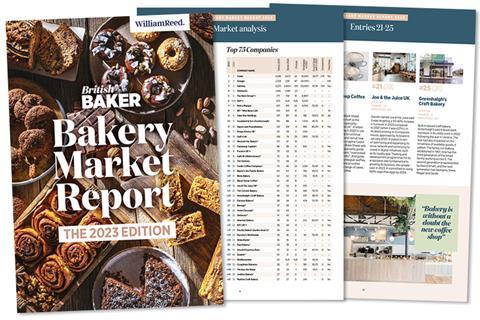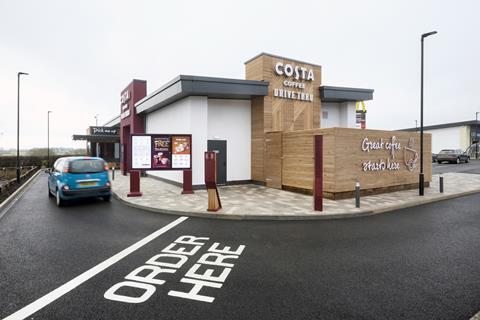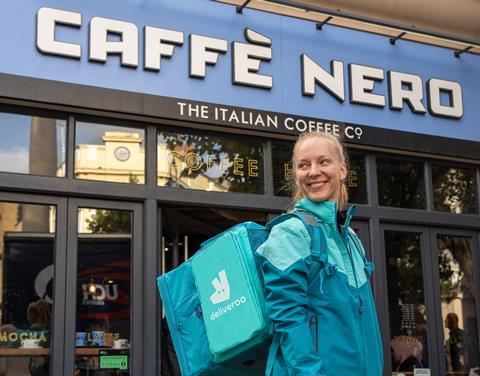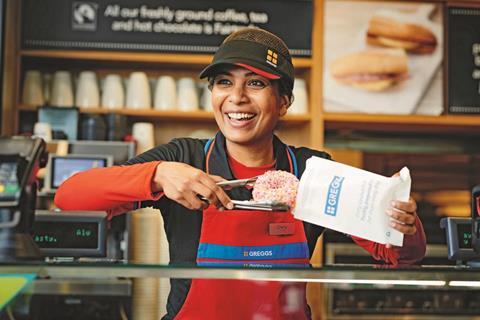Bakery Market Report 2023

Rising costs across the supply chain, coupled with a cost-of-living crisis, doesn’t make for the easiest of trading environments, particularly in a market often reliant on disposable income. And yet, the out-of-home bakery market is proving resilient.
“The out-of-home bakery market has seen stability returning after the pandemic, despite the cost-of-living crisis, settling around or above 2019 levels at the end of 2022,” explains Michael Schofield, marketing manager at bakery ingredients specialist British Bakels.
The total UK eating out market, according to data from Lumina Intelligence, reached £91.5bn in 2022, just 0.6% ahead of 2019 levels and 38% up year on year. However, value has been driven by inflation with the total market down in volume versus 2019 as consumers eat out less frequently.
“The coffee, bakery-led and sandwich channel has outperformed the total market, totalling £10.5bn in 2022 – 9.8% ahead of its 2019 total,” explains Katie Prowse, senior insight manager at Lumina Intelligence. “Several factors have underpinned this segment’s recovery and expansion, including continued strong physical outlet growth.”

CLICK HERE TO REGISTER OR LOGIN TO DOWNLOAD THE FULL BAKERY MARKET REPORT 2023
Gain free access to this unique snapshot of Britain’s out-of-home bakery market. The core of the report is the ‘BB75’ listing, which contains details of the country’s largest bakery-focused operators ranked by the number of stores they operate.
Information in the report includes:
- Number of sites operated (as of 1 January 2023)
- Year-on-year growth/decline in sites
- Number of employees
- Food and drink split
- Analysis of key activity in 2022
- Plans for 2023
Thirty seven of the 78 businesses listed as part of the Bakery Market Report 2023 have added to their estates over the past year and a further 21 are holding steady. Overall, the number of sites listed in the report is up 744 on last year, however much of this is due to the re-introduction of SSP (whose data was unavailable for 2022) and three firms making the list for the first time. The like-for-like increase in store numbers, meanwhile, sits at a respectable net total of 231. This represents a slow-down from the year before, when 420 new locations sprung up across the UK.
Notably, Greggs represents nearly two thirds of the net new sites with an increase of 147 as it continues its impressive growth strategy. Since 2018 the business has added nearly 500 new sites, with the number of additions over the past year the highest during that time.
If this growth rate continues it might not be long before Greggs tops the table – it currently sits in second place behind Costa which has 2,696 locations in the UK. Greggs has been clear about its vision to operate more than 3,000 shops in the UK and stated in its 2022 full-year results that it was expanding in new locations to achieve this, with sites inside supermarkets, travel hubs, retail parks and shopping centres on the agenda as it looks to meet the people where they are.
Omnichannel strategy
This strategy isn’t unique to Greggs, with many businesses stepping outside of their traditional stomping grounds to capture consumer attention.
Drive-thru is a particularly attractive format at present with the likes of Greggs, Costa, Starbucks, and Tim Hortons tapping into demand. According to the World Coffee Portal, these four added more than 100 drive-thru sites to their portfolios last year, with Dunkin’, Krispy Kreme, Stephens Bakery, and Baynes the Family Bakers among others embracing the format.

“Drive-thru expansion effectively targets consumers seeking out convenient meal solutions while on the go,” adds Lumina’s Prowse. “In a post-covid climate, stores near travel hub locations are increasingly important, making the consumer journey easier and more efficient.”
Click & collect and delivery are other channels designed to make it easier for consumers to get their treats, although Prowse believes delivery remains a relatively untapped opportunity for coffee, bakery, and sandwich operators. The sectors are set for the largest percentage growth in delivery turnover from 2020 to 2023, at 20.7%, although this is from a small base. Uber Eats, Prowse adds, said coffee is among the fastest-growing search terms on its platform.
“Delivery is an area where we expect to see growth,” adds Ian McGhee, president for trade body Scottish Bakers, who notes that the rise of these services show that consumers are willing to spend a little bit more for the convenience of having things brought to their doors.
“For bakeries looking to reach new and different customers, this has great potential to open up new markets and new routes to market,” he adds.
Caffè Nero is one firm to make inroads in the delivery arena, working with partners Deliveroo, Just Eat and Uber Eats. The coffee shop reported delivery sales of £3.5m for the six months from July to November 2022, although this represents a small proportion of its £150m UK revenue.
Speaking at the MCA Food To Go Conference earlier this year, Caffè Nero UK chief executive Will Stratton-Morris said the business’ venture into delivery had been a “real eye opener”. “Convenience is so powerful in terms of need states of consumers. They knew it wouldn’t be exactly the same as when they went up to the bar and bought a handcrafted barista drink, but it was delivered thanks to our partners in a quality way and in such a way that they were happy,” he said.

There are understandably operational challenges to overcome with delivery as well, including how to fulfil orders when there is a queue of customers in the shop.
“The more channels you operate in the bigger the challenge,” Stratton-Morris added. “It’s really important that any brand starts with a really clear definition of itself and has a really deep understanding of what it stands for to be able to then answer the question ‘which bits do I need to export into that channel?’.”
For Caffè Nero, Stratton-Morris believes this to be the fundamental hospitality experience of sitting in a coffee shop, enjoying a drink prepared by a friendly person. “It’s that you are trying to hold on to – that notion of quality service and warmth through the digital experience,” he said. “We remain a fundamentally store-driven business that is diversifying largely through digital channels, but not only, into a range of connected offers that feed off the core brand.”
But venturing too far out of usual markets could have an adverse effect, suggests Prowse. “Coffee brands including Starbucks and Costa are turning more to omnichannel approaches and are selling products on grocery shelves – this threatens some operators as it enables consumers to recreate the out of home coffee experience and quality in home, and for less money,” she adds.
Value for money
Regardless of how consumers choose to shop, with the cost of living rising, the key questions for operators remains: are consumers really cutting back? And does my offer deliver value for money?
“Consumer spending patterns due to the recession are having an impact for sure but initial concerns about spend in the away-from-home sector prior to Christmas seem to be unfounded,” says Tim Clarkson, cluster director UK and Ireland at supplier Dawn Foods.
Bakeries and coffee shops are more protected than other dine-in channels, notes Prowse at Lumina, as they are typically cheaper and more habitual with missions driven by needs such as commuting or being out and about.

“A small, sweet bakery treat made with quality ingredients is the ideal way for consumers to indulge without breaking the bank, so we are seeing many more individual serving sizes and mini formats, particularly with doughnuts and muffins in away from home,” Clarkson adds.
What this could also mean, according to Michael Schofield at British Bakels, is that consumers become more selective and conscious of their spending habits, resulting in a shift in the market.
“Having less cash available for discretionary spending is likely to mean people prioritising weekend treats rather than weekday ones in the out-of-home market, including going out for breakfasts, a major opportunity for bread and morning goods,” he says.
And, as Baker & Baker CEO John Lindsay points out, the cost-of-living crisis is “not affecting everyone equally”. “A considerable segment of society still wants to trade up and consume bakery products at the premium end of the market, so it’s important for retailers to understand their customer base and offer the choice of indulgence – but not at the expense of perceived value.”
Offering a range of products, across the price spectrum, is incredibly important in times like these, Lindsay adds.
Value for money is important at every price point – after all, consumers don’t want to feel like they’re being ripped off. It’s particularly pertinent as shoppers scrutinise spending, with some questioning whether companies are using inflation as an excuse to put prices up.
Boosting value credentials among consumers via subscription-based services and loyalty schemes, tiered ranges, and low-cost alternatives, are some of the ways operators are tackling this.

Pret’s Made Simple range
Value has been a focus for Pret in 2023, with the business unveiling a range of low-priced sandwiches targeted at consumers hit by the cost-of-living crisis. The Made Simple value range includes eight freshly-made sandwiches priced from £2.99, with Ham & Cheese, Egg Mayo, and Mature Cheddar & Pickle among the line-up. In April it also rebranded its coffee subscription, now called Club Pret, to include a 10% discount on food alongside up to five barista-prepared drinks a day for the price of £30 a month.
Club Pret is also an example of a loyalty-driving proposition – a tactic that is gaining popularity. Gail’s is among those embracing apps to drive loyalty, having unveiled its first digital offering this year. Customers gain one stamp per visit to its stores, or two if they spend more than £20, as well as other benefits including a sweet treat during their birthday month. Costa has a similar scheme. Called Costa Coffee Club, the app-led loyalty programme offers customers a free drink for every eight purchased, as well as free cake on their birthday and extra rewards for using a reusable cup.
The people problem

Fostering loyalty and engagement among staff is an entirely different challenge as the market continues to face an uphill battle with recruitment.
“Staffing remains a big issue for the sector, as indeed it is across the whole of the food economy,” says Scottish Bakers’ McGhee, noting that almost all of the trade body’s members are reporting difficulties in recruiting for staff across all job roles. “This is placing pressure on businesses and staff already in work who are seeing their workloads increase to cope,” he adds.
Both Pret and Costa have increased their employees’ pay three times over the past year with the increases totally a 19% and 14% uplift, respectively, over the period. Alongside this, both have also improved the benefits offered to staff, with Pret opening an online discount portal that gives staff access to fresh food and other essential items from supermarkets and other businesses at a lower cost. Costa, meanwhile, increased its staff discount from 25% to 50%, and switched the payment of bonuses linked to the store from vouchers to a direct payment.
“Although salary will always be an important recruitment driver, workplace culture and progression are equally valued by employees,” adds Baker & Baker’s Lindsay.
Cost efficiency
Paying staff well does come at a cost, albeit a business critical one. Couple this with inflation, higher raw materials and energy prices, and the cost of simply doing business is rising.
“Costs have been the major challenge for all bakery businesses over the past 12 months and this is likely to continue in the short to medium term,” explains McGhee at Scottish Bakers. “While demand remains robust and indeed growing in many cases, margins have been hit hard as bakeries try to absorb as much of the additional cost base as they can to protect hard-pressed consumers.”
However, he adds, retail prices have had to rise across the board to ensure survival of businesses.
Craft Bakers Association chief executive Karen Dear concurs, noting that inflation is having a significant impact on high street bakery firms, with several tactics employed to counteract this.
“Nearly two thirds (64%) of Craft Bakers Association members surveyed have increased the price of out-of-home baked goods including sandwiches and rolls by 10% or above,” she explains. “In an attempt to cut costs further, a third have switched suppliers, 39% have reduced the range they sell and 8% have reduced the size or volume of some products.”
Consumers are still chomping through baked goods as Dear highlights that four in 10 CBA members reported an increase in sales, with only 11% noting a decline despite the difficult circumstances.
The next year is unlikely to be easy to navigate, but the past few years have taught operators how to be nimble and adapt to an ever-changing landscape. As such, many are optimistic about the future. Some businesses will survive while others, who have a clear understanding of what their customers are looking for and how to target them effectively, will likely thrive.
To continue reading, register for free
You are what you read, registration is quick, easy and free. Just click register now and you’ll be finished faster than it takes you to butter a crumpet!
Don’t miss out:
- Unlimited access to content
- Regular newsletters to your inbox
- Save articles to read later on
- A more personalised experience
Already registered? Please log-in here


















